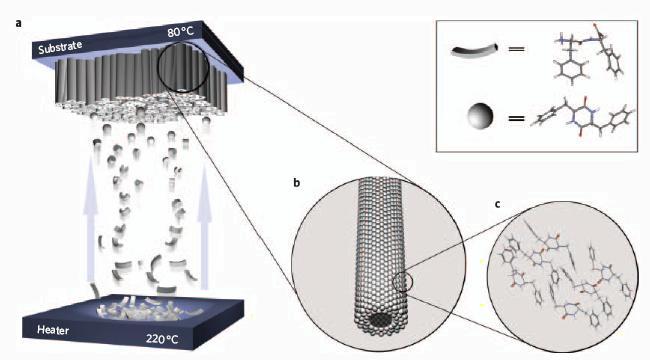Another possible application: powerful batteries for electric vehicles. The research, shared by two different groups - one from the Faculty of Life Sciences and the other from the Faculty of Engineering, is published today in the journal Nature Nanotechnology

Ongoing research in the field of nanotechnology carried out at Tel Aviv University has yielded these days a method for the self-organization of nanoscale materials that has practical implications for the day-to-day lives of all of us in the not-too-distant future.
The discovery is shared by Prof. Ehud Gazit's group and the research student in his laboratory, Lehi Adler-Abramovich from the George S. Wise at Tel Aviv University, as well as Prof. Gil Rosenman, and his research student Danny Aronov from the Faculty of Engineering at Tel Aviv University and other members of both research groups.
The method developed by the members of the two groups and which is presented today in an article published in the journal Nature Nanotechnology will allow the creation of powerful capacitors in rechargeable batteries (in particular for applications in the field of the electric car), or alternatively, they can be used to build windows or solar collectors (or any other required surface) that will repel water as well as They will clean themselves, without human contact.
The research demonstrates the multidisciplinarity of nanotechnology, when biology, chemistry and physics mix together to create completely new products, in this case, protein nanotubes. As you know, the proteins (peptides) are biological material, environmentally friendly, used for nanotechnology applications that are not in the field of biology or medicine.
The researchers developed a method in which they can arrange the protein nanotubes perpendicularly to the surface and in addition can control the thickness and density of the layer of nanostructures. The method is based on volatilizing the protein building blocks that build the nanotube under vacuum and high temperature conditions. The result is a uniform and orderly surface of protein nanotubes. The arrangement of the nanotubes leads to a significant increase in surface area.
The simple technology that improves the precise arrangement of the nanotubes opens a window to a variety of applications. As mentioned, in this work the researchers showed examples of two applications based on the ordered surfaces of the nanotubes: the first is the use of the ordered nanotube surface to create supercapacitors with high power density and high energy density, which can be integrated into rechargeable batteries, to provide fast and high-energy pulses (for example, when jumping ).
The second application is the creation of smart windows, this application is based on the creation of a super-hydrophobic layer, the arranged nanometer tubes create a uniform surface that repels water. Coating a window with the nanotubes will not allow water drops to wet it, but will cause the water drops to roll down the surface and collect waste and dust particles with them, thus cleaning the surface. Thus, every rain will lead to a complete cleaning of the window, and as for solar collectors, coatings with the new surface will allow them to be placed in remote but sunny places, without fearing that the sand in the desert will cause them to decrease in productivity.
These protein nanotubes were also found to be resistant to high temperatures and extreme conditions, which will allow their integration into manufacturing processes in microelectronics. In addition, the biological origin of these substances will allow medical and biotechnological applications.
In December 2006, the journal Nature Nanotechnology dedicated its cover to an article by Prof. Ehud Gazit and members of his laboratory, which dealt with the application of those protein nanotubes as an artificial nose for detecting explosives and toxins in extremely low concentrations.

4 תגובות
Nice, now you don't have to clean on Pesach anymore.
The main thing is that the patent will expire quickly.
!!!!!!!!!!!!!
!
I read so many articles about nanotechnology and it really appeals to me to study it at university.
Can someone help me get more details on this!!!!!!
My email is attached!!!
"The near future is nano, I wonder what will happen in the distant future?"